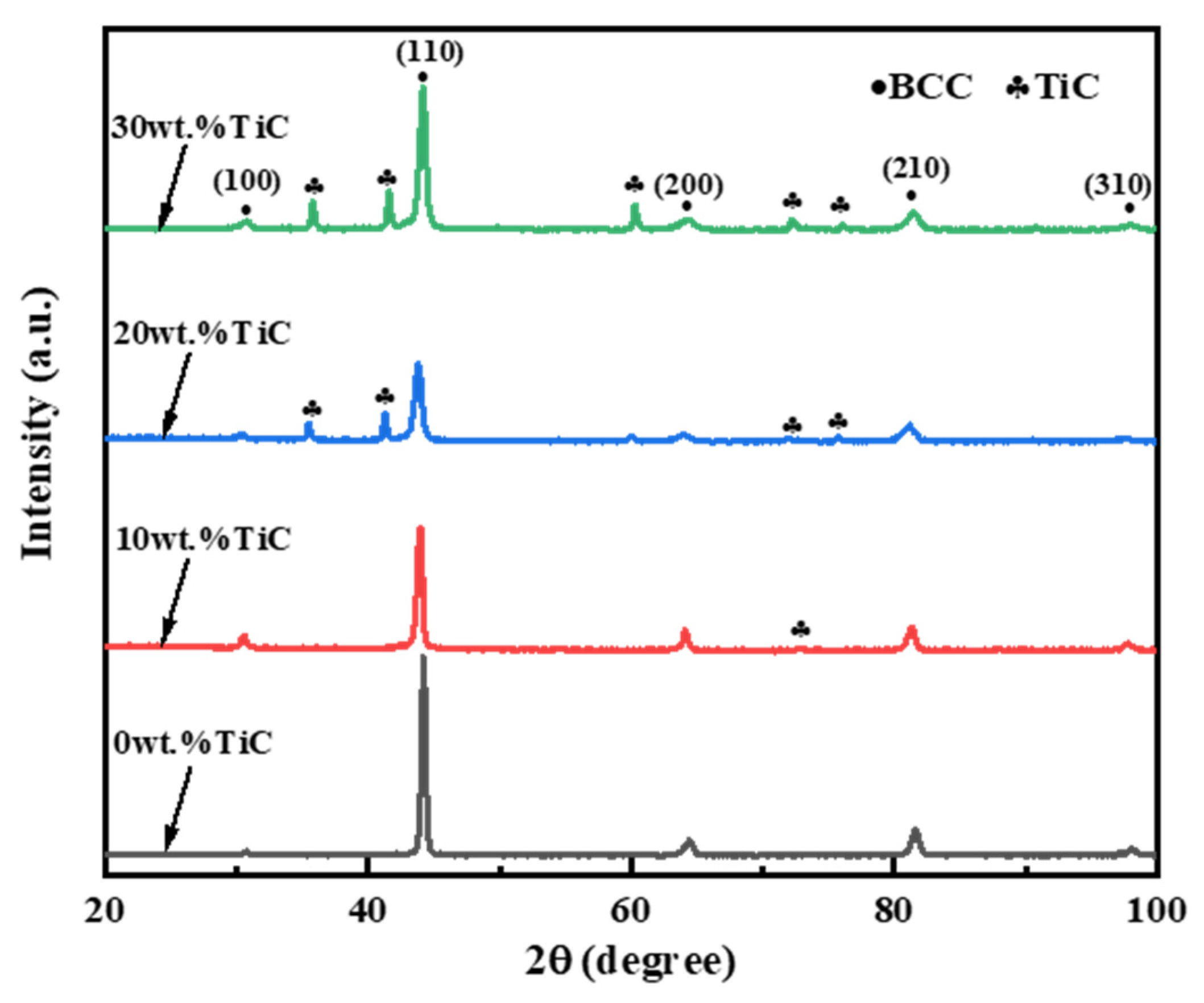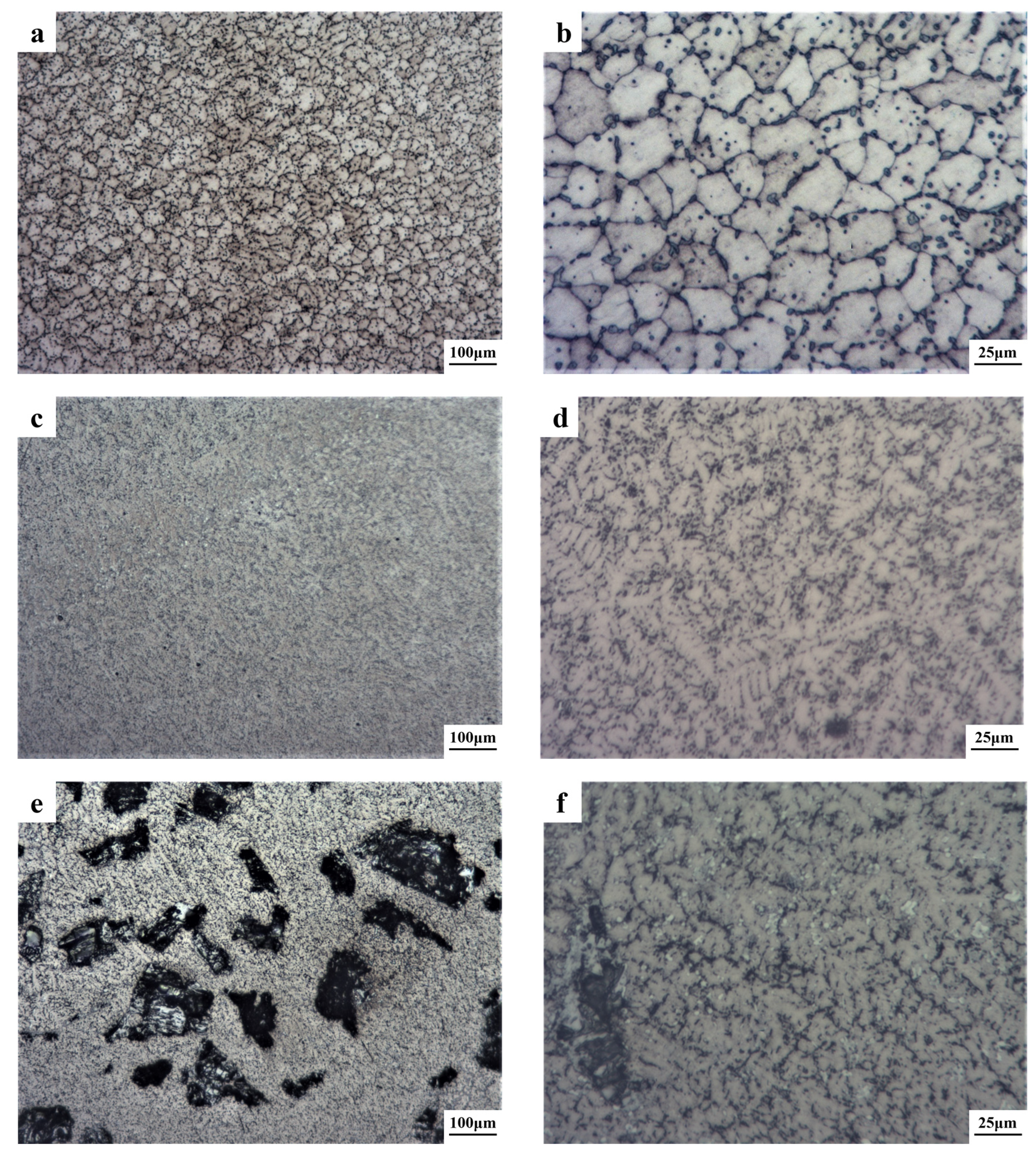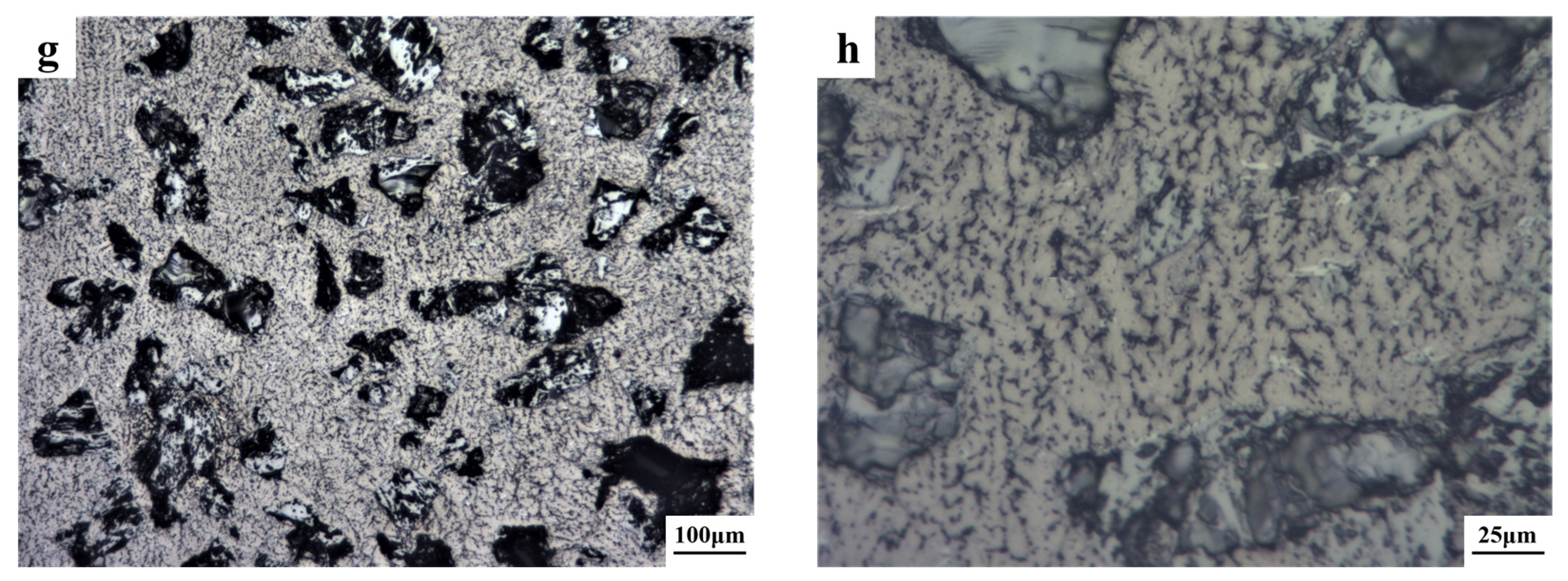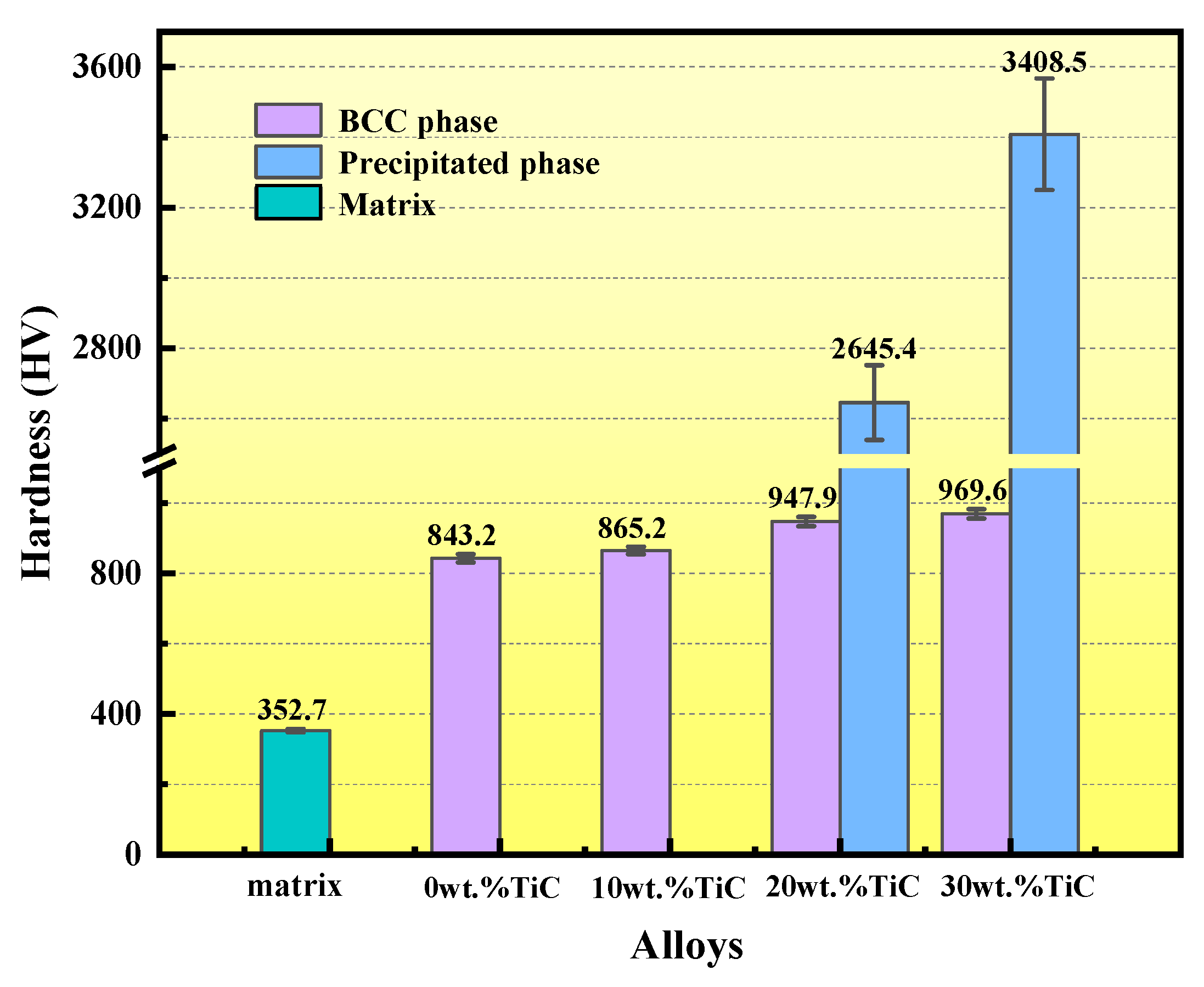Structure and Wear Resistance of TiC-Reinforced Al1.8CrCuFeNi2 High-Entropy Alloy Coating Using Laser Cladding
Abstract
:1. Introduction
2. Materials and Methods
2.1. Preparation of TiC-Reinforced High-Entropy Alloy Coating
2.2. Structure Analysis
2.3. Analysis of Hardness and Wear Resistance
3. Results and Discussions
4. Conclusions
- (1)
- A single solid solution of BCC was formed in the Al1.8CrCuFeNi2 HEA. The 10 wt.% TiC coating was still a single solid solution of BCC without obvious TiC agglomeration particles. The TiC-agglomerated particles appeared in both the 20 wt.% TiC and the 30 wt.% TiC coating. After adding TiC, the grain size clearly decreased.
- (2)
- Due to the fine-grain strengthening and dispersion strengthening of TiC, with the increase in TiC content, the hardness of the high-entropy alloy coatings clearly increased. The hardness of the 30 wt.% TiC coating was the highest.
- (3)
- The wear resistance of the Al1.8CrCuFeNi2 HEA coatings could be significantly enhanced with the addition of TiC. Due to the increase in hardness, the 30 wt.% TiC/Al1.8CrCuFeNi2 composite coating had the best wear resistance.
Author Contributions
Funding
Institutional Review Board Statement
Informed Consent Statement
Data Availability Statement
Conflicts of Interest
References
- Zhu, Y.; Liu, X.; Liu, Y.; Wang, G.; Wang, Y.; Meng, Y.; Liang, J. Development and characterization of Co-Cu/Ti3SiC2 self-lubricating wear resistant composite coatings on Ti6Al4V alloy by laser cladding. Surf. Coat. Technol. 2021, 424, 127664. [Google Scholar] [CrossRef]
- Liang, G.; Jin, G.; Cui, X.; Qiu, Z.; Wang, J. The directional array TiN-reinforced AlCoCrFeNiTi high-entropy alloy synthesized in situ via magnetic field-assisted laser cladding. Appl. Surf. Sci. 2022, 572, 151407. [Google Scholar] [CrossRef]
- Ma, Z.H.; Zhai, Q.; Wang, K.L.; Chen, G.X.; Yin, X.T.; Zhang, Q.X.; Meng, L.T.; Wang, S.H.; Wang, L. Fabrication of Fe-based metallic glass reinforced FeCoNiCrMn high-entropy alloy through additive manufacturing: Mechanical property enhancement and corrosion resistance improvement. J. Mater. Res. Technol. 2022, 16, 899–911. [Google Scholar] [CrossRef]
- Chen, C.; Yuan, S.H.; Chen, J.L.; Wang, W.; Zhang, W.W.; Wei, R.; Wang, T.; Zhang, T.; Guan, S.K.; Li, F.S. A Co-free Cr-Fe-Ni-Al-Si high entropy alloy with outstanding corrosion resistance and high hardness fabricated by laser surface melting. Mater. Lett. 2022, 314, 131882. [Google Scholar] [CrossRef]
- Xing, Q.W.; Feltrin, A.C.; Akhtar, F. Processing, microstructure and high temperature dry sliding wear of a Cr-Fe-Hf-Mn-Ti-Ta-V high-entropy alloy based composite. Mater. Today Commun. 2021, 28, 102657. [Google Scholar] [CrossRef]
- Hong, S.C.; Li, J.; Zhao, P.; Xu, Y.S.; Li, W.G. Evolution in wear and high-temperature oxidation resistance of laser-clad AlxMoNbTa refractory high-entropy alloys coatings with Al addition content. Coatings 2022, 12, 121–141. [Google Scholar] [CrossRef]
- Cui, P.C.; Liu, Y.; Zhou, F.; Lai, Z.H.; Zhu, J.C. Enhancing high temperature mechanical properties via modulating B2 phase with Al contents in FeCrNiAlx (x = 0.63,0.71,0.77) high entropy alloys. J. Alloys Compd. 2022, 930, 163883. [Google Scholar] [CrossRef]
- Kong, D. Microstructure and Properties of Al1.8CrCuFeNi2 High Entropy Alloy Formed by Selective Laser Melting. Master’s Thesis, Shandong Agricultural University, Tai’an, China, 2020. [Google Scholar]
- Jiang, X.J.; Wang, S.Z.; Fu, H.; Chen, G.Y.; Ran, Q.X.; Wang, S.Q.; Han, R.H. A novel high-entropy alloy coating on Ti-6Al-4V substrate by laser cladding. Mater. Lett. 2022, 308, 131131. [Google Scholar] [CrossRef]
- Liu, H.; Li, X.F.; Hua, P.; Song, K.J.; Teng, P.; Wei, W. Microstructure and properties of laser-cladded Fe50Mn30Co10Cr10 high entropy alloy coatings. J. Therm. Spray Technol. 2022, 31, 991–999. [Google Scholar] [CrossRef]
- Shi, F.K.; Zhang, Q.K.; Xu, C.; Hu, F.Q.; Yang, L.J.; Zheng, B.Z.; Song, Z.L. In-situ synthesis of NiCoCrMnFe high entropy alloy coating by laser cladding. Opt. Laser Technol. 2022, 151, 108020. [Google Scholar] [CrossRef]
- Xu, C.; He, D.W.; Wang, H.K.; Wang, W.D.; Tang, M.J.; Wang, P. Synthesis of novel superhard materials under ultrahigh pressure. Chin. Sci. Bull. 2014, 59, 5251–5257. [Google Scholar] [CrossRef]
- Chen, S.Y.; Chen, X.L.; Wang, L.; Liang, J.; Liu, C.S. Laser cladding FeCrCoNiTiAl high entropy alloy coatings reinforced with self-generated TiC particles. J. Laser Appl. 2021, 5, 583–592. [Google Scholar] [CrossRef]
- Meena, L.; Babaji, G. Synthesis and characterisation of natural ceramic reinforced Titanium Metal Matrix composite. Can. Metall. Q. 2021, 37, 41–44. [Google Scholar]
- Chen, Y.H.; Sun, S.W.; Zhang, T.M.; Zhou, X.W.; Li, S.H. Effects of post-weld heat treatment on the microstructure and mechanical properties of laser-welded NiTi/304SS joint with Ni filler. Mater. Sci. Eng. A 2020, 771, 138545–138551. [Google Scholar] [CrossRef]
- Liang, J.; Jia, X.Y.; Liu, Y.; Yin, X.Y.; Chen, S.Y.; Liu, C.S. Microstructure and tribological properties of in-situ TiC reinforced Ti2AlNb-based coatings by laser cladding. Surf. Coat. Technol. 2022, 446, 128787–128799. [Google Scholar] [CrossRef]
- Lv, Y.T.; Zhang, Z.; Zhang, Q.; Wang, R.; Sun, G.B.; Chen, X.Z.; Yu, H.Y.; Bi, Z.N.; Xie, J.L.; Wei, G.J. Cracking inhibition behavior and the strengthening effect of TiC particles on the CM247LC superalloy prepared by selective laser melting. Mater. Sci. Eng. A 2022, 858, 144119. [Google Scholar] [CrossRef]
- Wu, J.F.; Zhu, W.D.; Yu, W.K.; Ma, H.W.; Shao, Y. Effect of TiC additions on the microstructure, mechanical and tribological properties of NbC-CoCrFeNiMn high entropy alloys cermets. Int. J. Refract. Hard. Met. 2023, 112, 106141. [Google Scholar] [CrossRef]
- Tong, Y.G.; Cai, Y.L.; Hu, Y.L.; Huang, H.F.; Zhang, X.C.; Zhang, H. TiC strengthened CoCrNi medium entropy alloy: Dissolution and precipitation of TiC and its effect on microstructure and performance. Trans. Nonferrous Met. Soc. China 2022, 32, 2266–2275. [Google Scholar] [CrossRef]
- Huang, S.; Sun, D.Q.; Wang, W.Q.; Xu, H.Y. Microstructures and properties of in-situ TiC particles reinforced Ni-based composite coatings prepared by plasma spray welding. Ceram. Int. 2022, 41, 12202–12210. [Google Scholar] [CrossRef]
- Neamah, Z.J.; Ahmed, B.A.; Thejeel, M.A.N.; Jasim, K.A.; Shaban, A.H. The effect of gamma radiation on the manufactured HgBa2Ca2Cu2.4Ag0.6O8+δ compound. Mater. Sci. Forum 2022, 6298, 41–47. [Google Scholar] [CrossRef]
- Abdel-Rahman, M.; Ibrahim, H.; Mostafa, M.Y.A.; Abdel-Rahman, M.A.; Ebied, M.R.; Badawi, E.A. The characterization of ZnO nanoparticles by applying x-ray diffraction and different methods of peak profile analysis. Phys. Scr. 2021, 96, 095704. [Google Scholar] [CrossRef]
- Fang, J.X.; Wang, J.X.; Wang, Y.J.; He, H.T.; Zhang, D.B.; Cao, Y. Microstructure evolution and deformation behavior during stretching of a compositionally inhomogeneous TWIP-TRIP cantor-like alloy by laser powder deposition. Mater. Sci. Eng. A 2022, 847, 143319–143333. [Google Scholar] [CrossRef]
- Zhang, Z.Q.; Yang, Q.; Yu, Z.M.; Wang, H.; Zhang, T.G. Influence of Y2O3 addition on the microstructure of TiC reinforced Ti-based composite coating prepared by laser cladding. Mater. Charact. 2022, 189, 111962. [Google Scholar] [CrossRef]
- Zhao, C.; Yang, J.M. Mechanical Engineering Materials, 3rd ed.; Machine Press: Beijing, China, 2015; pp. 6–7. [Google Scholar]








| Content | Model/Parameter |
|---|---|
| Laser | YLS-4000 |
| Laser cladding head | YC52 |
| Powder feeder | AFS-PF-D |
| Six-axis industrial robot | KR30HA |
| Double-axis turntable | KUKA DKP400 |
| Vertical and horizontal single-axis turntable | HR-630R |
| Mobile workbench | 1500\times1000 |
| Inert gas purification system | GP400 |
| Time | 65 Mn | 0 wt.% TiC | 10 wt.% TiC | 20 wt.% TiC | 30 wt.% TiC |
|---|---|---|---|---|---|
| 30 min | 21.6 ± 1.3 | 11.7 ± 0.5 | 11.3 ± 0.5 | 2.1 ± 0.1 | 2.2 ± 0.1 |
| 120 min | 38.1 ± 2.1 | 37.1 ± 1.5 | 36.5 ± 0.7 | 9.1 ± 0.2 | 8.1 ± 0.4 |
Disclaimer/Publisher’s Note: The statements, opinions and data contained in all publications are solely those of the individual author(s) and contributor(s) and not of MDPI and/or the editor(s). MDPI and/or the editor(s) disclaim responsibility for any injury to people or property resulting from any ideas, methods, instructions or products referred to in the content. |
© 2023 by the authors. Licensee MDPI, Basel, Switzerland. This article is an open access article distributed under the terms and conditions of the Creative Commons Attribution (CC BY) license (https://creativecommons.org/licenses/by/4.0/).
Share and Cite
Guo, J.; Liu, C.; Wang, D.; Xu, L.; Song, K.; Gao, M. Structure and Wear Resistance of TiC-Reinforced Al1.8CrCuFeNi2 High-Entropy Alloy Coating Using Laser Cladding. Materials 2023, 16, 3422. https://doi.org/10.3390/ma16093422
Guo J, Liu C, Wang D, Xu L, Song K, Gao M. Structure and Wear Resistance of TiC-Reinforced Al1.8CrCuFeNi2 High-Entropy Alloy Coating Using Laser Cladding. Materials. 2023; 16(9):3422. https://doi.org/10.3390/ma16093422
Chicago/Turabian StyleGuo, Jing, Chenghao Liu, Dexing Wang, Lingfeng Xu, Kaikai Song, and Ming Gao. 2023. "Structure and Wear Resistance of TiC-Reinforced Al1.8CrCuFeNi2 High-Entropy Alloy Coating Using Laser Cladding" Materials 16, no. 9: 3422. https://doi.org/10.3390/ma16093422






